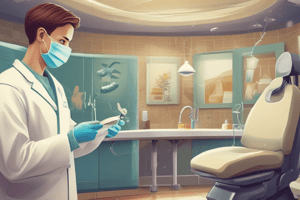Podcast
Questions and Answers
What is the primary purpose of sterilization?
What is the primary purpose of sterilization?
Which of the following best describes cold sterilization?
Which of the following best describes cold sterilization?
Why should disinfectants and antiseptics not be used interchangeably?
Why should disinfectants and antiseptics not be used interchangeably?
Which characteristic is NOT essential for an ideal disinfectant?
Which characteristic is NOT essential for an ideal disinfectant?
Signup and view all the answers
Critical instruments must be:
Critical instruments must be:
Signup and view all the answers
What is the main purpose of pre-cleaning surfaces in a dental environment?
What is the main purpose of pre-cleaning surfaces in a dental environment?
Signup and view all the answers
Which type of surface could be classified as a clinical contact surface?
Which type of surface could be classified as a clinical contact surface?
Signup and view all the answers
What role does personal protective equipment (PPE) play during the disinfection process?
What role does personal protective equipment (PPE) play during the disinfection process?
Signup and view all the answers
Which best describes disinfection in a dental setting?
Which best describes disinfection in a dental setting?
Signup and view all the answers
What is one of the approaches to ensure environmental surface asepsis in dental practices?
What is one of the approaches to ensure environmental surface asepsis in dental practices?
Signup and view all the answers
Study Notes
Environmental Infection Control
- Microorganisms can survive on environmental surfaces for varying durations, influenced by factors like temperature, humidity, and presence of blood and saliva.
- Proper removal or inactivation of microorganisms is crucial before treating subsequent patients.
- Dental environmental surfaces are classified as clinical contact surfaces and housekeeping surfaces.
- Clinical contact surfaces are frequently touched during patient care and may become contaminated with blood, saliva, or other potentially infectious material.
- Housekeeping surfaces, like walls and sinks, typically do not come in contact with hands or devices used in dental procedures.
- Treatment of clinical surfaces is essential before treating the next patient, while housekeeping surfaces can be treated at the end of the day.
Surface Asepsis
- Two approaches for environmental surface asepsis include surface covers and pre-cleaning and disinfection.
- Surface covers, like plastic-barrier sticky tape, are used to protect smooth surfaces.
- Pre-cleaning is crucial to reduce the initial bio-burden, allowing disinfection to be more effective.
- Personal protective equipment (PPE) should always be worn when disinfecting surfaces and equipment.
Disinfection & Sterilization
- Disinfection: Reduces the number of viable microorganisms but may not inactivate some viruses and bacterial spores.
- Sterilization: Destroys or removes all microorganisms, including spores.
- Initial removal of material through cleaning and use of an ultrasonic device facilitates sterilization.
- Cold sterilization involves soaking contaminated objects in a chemical solution like glutaraldehyde for approximately 10 hours.
Disinfectants & Antiseptics
- Disinfectants: Chemicals applied to inanimate surfaces like dental equipment.
- Antiseptics: Antimicrobial agents applied to living tissue.
- Interchangeability of disinfectants and antiseptics is strictly prohibited due to potential tissue toxicity and equipment damage.
The "Perfect Disinfectant?"
- The ideal surface disinfectant should have rapid killing action for a broad spectrum of bacteria, be non-toxic and non-allergic, not damage surfaces, be odorless, inexpensive, simple to use, active in the presence of organic matter, active at varying pH levels, and have a long shelf-life.
Patient Care Equipment
- Dental instruments can be categorized into disposable and reusable items.
- Spaulding classification categorizes instruments into critical, semi-critical, and non-critical.
Critical Instruments
- Critical instruments penetrate soft tissue or bone.
- They must be heat sterilized between each use or disposable items used.
- Examples include periodontal probes, scalars, explorers, surgical instruments, and surgical dental burs.
Semi-Critical Instruments
- Semi-critical instruments do not penetrate soft tissue or bone but contact oral tissues.
- They require heat sterilization or high-level disinfection after each use.
- Examples include mouth mirrors, handpieces, restorative instruments, and impression trays.
Non-Critical Instruments
- Non-critical instruments contact intact skin.
- They are cleaned and disinfected using a low to intermediate level disinfectant.
- Examples include light cure tips, switches on dental chairs, x-ray heads, face bows, pulse oximeter, and blood pressure cuffs.
Infection Control Practices
- Use surface barriers to protect clinical contact surfaces, especially those that are hard to clean.
- Change surface barriers between patients.
- Clean and disinfect un-covered clinical contact surfaces and equipment with a hospital-level disinfectant (active against HIV, HBV, and Mycobacterium tuberculosis) after each patient.
- Sodium hypochlorite (household bleach) is an effective and economical surface disinfectant.
Safe Waste Disposal
- General waste or non-hazardous waste: Poses no risk of infection; includes items like paper, boxes, or hand towels.
- Bio-hazardous waste: Includes items contaminated with infectious or potentially infectious substances like blood or saliva; poses a risk to humans or the environment.
Waste Disposal Guidelines
- Infectious waste should not be mixed with general waste.
- General waste is disposed of in black bags, while infectious waste is placed in leak-proof red bags.
- Waste bags should not be overfilled (maximum 2/3 full).
- Personnel must wear heavy-duty gloves while handling waste bags.
Handling Sharp Items
- Disposable needles must not be bent, broken, recapped by two hands, removed from syringes, or otherwise manipulated by hand before disposal.
- The "scoop technique" (one-hand technique) can be used for recapping syringes.
- Sharp subjects should be placed in puncture-resistant containers.
- Sharps containers must be color-coded or labeled, tightly closable, leak-proof, and placed as close as feasible to the location of use.
Studying That Suits You
Use AI to generate personalized quizzes and flashcards to suit your learning preferences.
Related Documents
Description
This quiz explores the principles of infection control in dental settings, focusing on the survival of microorganisms on surfaces and the importance of proper surface asepsis. Understand the distinction between clinical contact surfaces and housekeeping surfaces, and learn effective strategies for disinfecting them to ensure patient safety.



